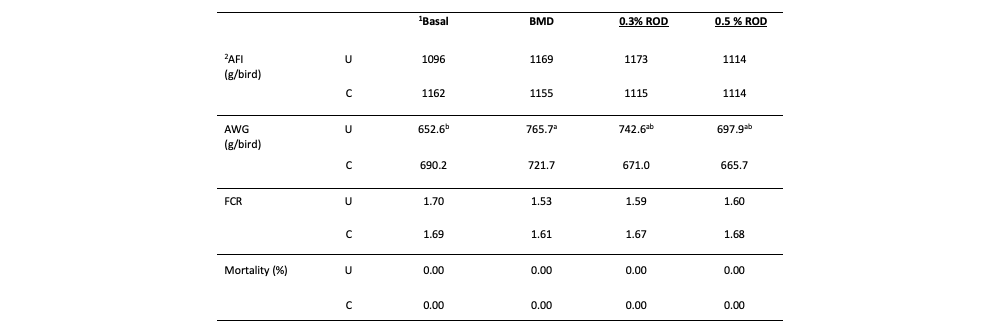


 Français
Français


The search for alternatives to antibiotics in poultry production continues to be an ongoing challenge. The industry is working to find antibiotic replacements that ensure the production of healthy birds and ensure that intestinal pathogenic bacteria do not cause food- borne infections for humans. Dr. Adewole and her team of graduate students are investigating feed additives to determine their potential to replace the use of in-feed antibiotics in chicken production. Red osier dogwood (ROD;Cornus stolonifera) is a naturally growing ornamental shrub found in all provinces in Canada. ROD is a novel feed ingredient which is high in polyphenols, known for their antioxidant and health properties. Scales (2015) found that ROD added to the diets of weaned pigs reduced antibiotic usage. As well, Amarokoon (2017) reported that it provided protection to weanling pigs against oxidative stress induced by E. coli infection. This study investigated ROD’s antioxidant and antimicrobial effects on broiler chickens when their immune system is stressed with an injection of Salmonella Enteritidis lipopolysaccharide (SE-LPS), a biomolecule produced when the SE bacterium is broken down. This is not a live form of the SE bacterium but a metabolite that can have a negative impact on bird health.
The objective of this study was to investigate the potential of ROD extract at 0.3% and 0.5% as an alternative to in-feed antibiotics on growth performance, blood biochemical parameters, gut health, and antioxidant status of broiler chickens challenged with SE-LPS.
This study indicates that dietary supplementation of ROD extract at 0.3% or 0.5% can be used to replace antibiotics in broiler chicken nutrition without a negative impact on growth performance.
Day old broiler chickens (Cob 500) were randomly assigned to eight treatment groups containing eight replicate cages of 6 birds each. There were two groups (challenged and unchallenged) and 4 dietary treatments as follows:
Diet 1 (NC) – Negative control i.e., corn-wheat soybean-based diet
Diet 2 (BMD) – NC diet plus 0.05% BMD (antibiotic)
Diet 3 (ROD 0.3) – NC diet plus 0.3% ROD Extract Diet 4 (ROD 0.5) – NC diet plus 0.5% ROD Extract
The unchallenged group was fed the above diets and on d 13 and 20 were given an injection of a buffered saline solution. The challenged group was given an injection of SE-LPS on d 13 and 20. Average body weight (ABW) and average feed intake (AFI) were determined weekly on a cage basis, and mortality was recorded daily to correct for AFI and feed conversion ratio (FCR). On d 21, 80 birds (ten birds from each treatment) were randomly selected, individually weighed, and euthanized. On Day 36, two birds were randomly selected from each pen and euthanized. Blood samples and ceca content were collected, and gut morphology was examined. The following parameters were determined: feed intake, body weight, body weight gain, feed conversion ratio, organ weights, concentration of SCFAs, blood chemistry and identification of gut microbiota.

References
Amarakoon, A. M. S. B. K. 2017. Regulation of oxidative stress in weaned piglets challenged with Escherichia coli. MSc thesis, University of Manitoba.
Scales, R. 2015. Anti-oxidant properties of Cornus sericea, US Patent 20150093460.
Researcher and Cooperators
Deborah Adewole, Taiwo Erinle, Fisayo Akinyemi, Janice MacIsaac, and Chengbo Yang
Funding/Support
Canada/Nova Scotia Canadian Agricultural Partnership Program, Chicken Farmers of Nova Scotia, NSERC, Red Dogwood Enterprises Ltd (Swan River, MN)
Adapted from the Atlantic Poultry Research Institute’s Factsheets
PO Box 550 Truro, NS B2N 5E3 (902) 893-6657
Laurie.Eagles@dal.ca www.APRinstitute.ca

